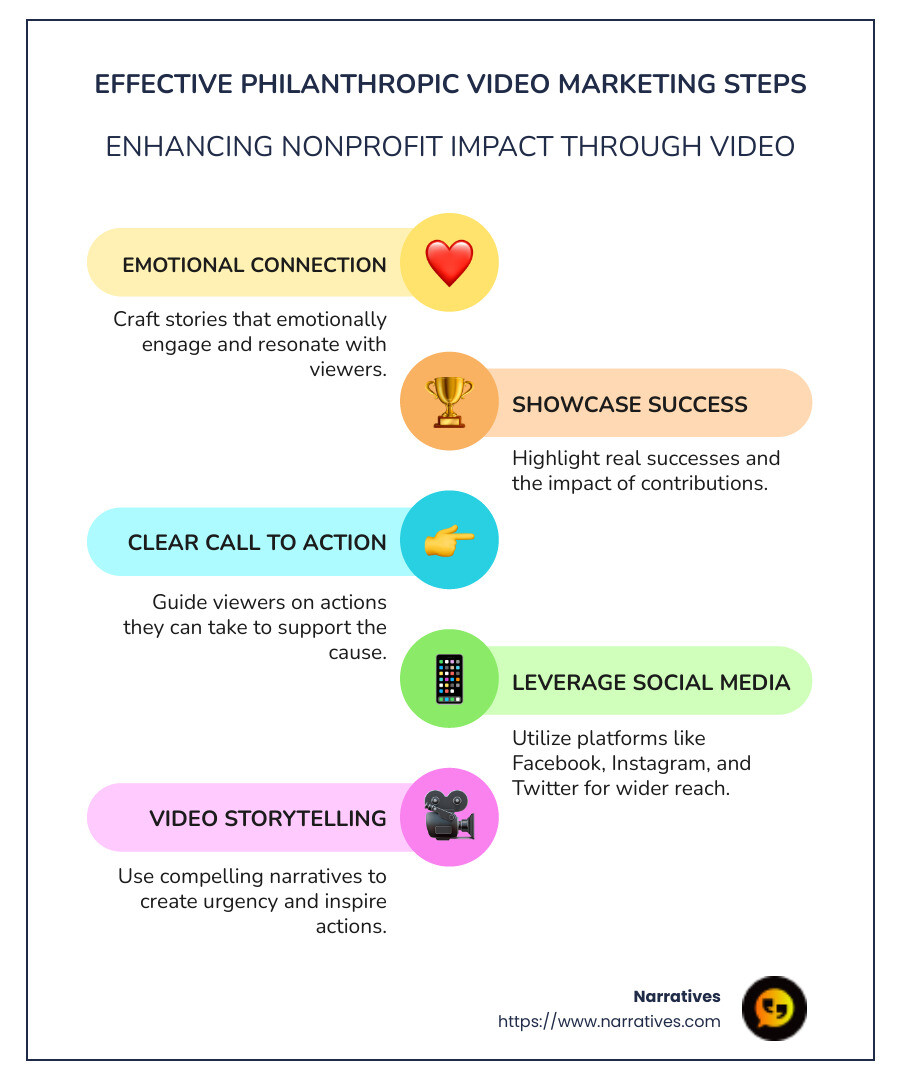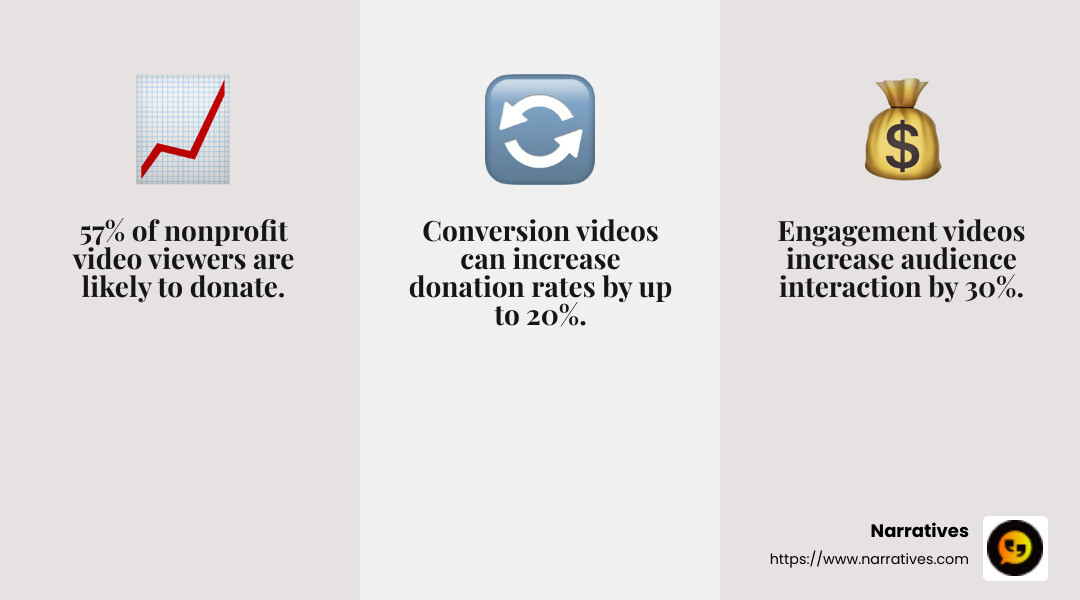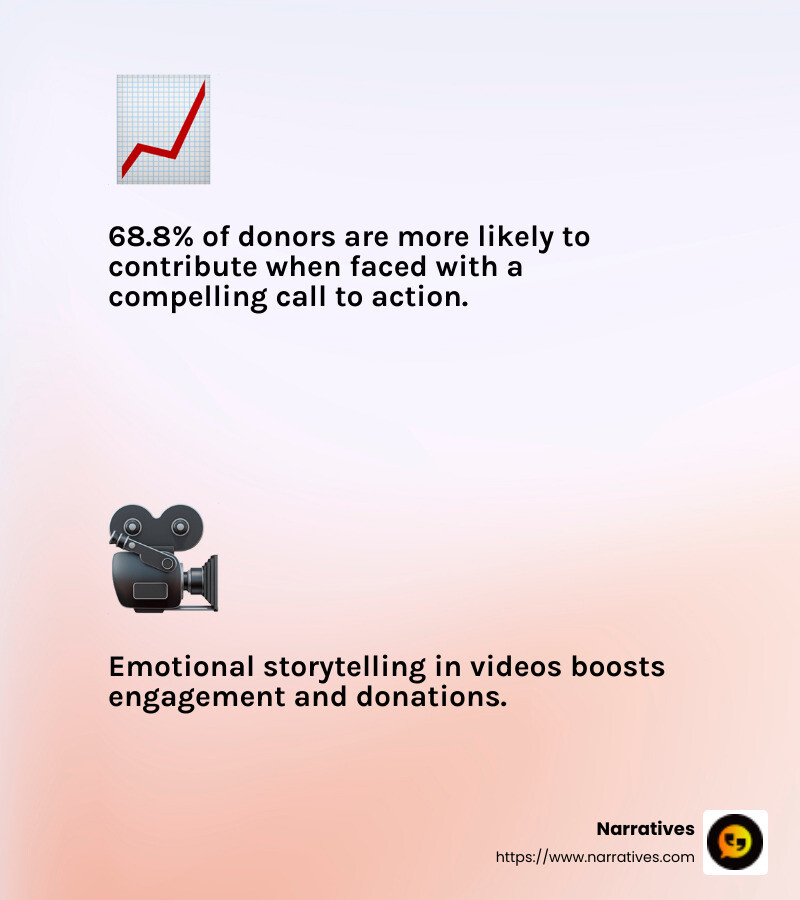Philanthropic Video Strategies: A Step-by-Step Approach

Philanthropic video strategies are vital in today's digital landscape, where compelling content can lift nonprofit missions. Engaging these strategies ensures your cause resonates with audiences, expands reach, and boosts engagement. Here's what you need to know to get started:
- Emotional Connection: Use videos to tell stories that tug at viewers' heartstrings.
- Highlight Success Stories: Showcase the impact of donations or volunteers.
- Clear Call to Action: Direct viewers on how they can contribute.
- Leverage Social Media: Reach broader audiences where they already are.
In a world dominated by visuals, nonprofit organizations are using the power of video to connect with supporters in ways traditional methods can’t. Videos bring the work of nonprofits to life, showing not just talking points but real people and transformative stories.
The COVID-19 pandemic showcased the necessity of digital connection, with many organizations successfully using video to maintain audience bonds and highlight success stories despite the physical distances. Video marketing is not just about creating content but creating a sense of connection and urgency that encourages viewers to act.
By integrating compelling narratives with clear calls to action, philanthropic video strategies open a pathway for viewers to engage meaningfully. These videos cut through the noise of online content with potent storytelling that not only informs but inspires.

Understanding Philanthropic Video Strategies
Video advertising in the nonprofit sector is about more than just spreading awareness. It's about crafting a message that resonates and drives action. With most people watching videos on their smartphones, ensuring your content is mobile-friendly and versatile is key.
Content marketing through video allows nonprofits to share their mission in engaging ways. Videos can be repurposed across platforms—social media, websites, and email campaigns—maximizing reach and resource efficiency. A single video can serve multiple functions, making it a smart investment for any nonprofit.
But what truly sets successful philanthropic video strategies apart is storytelling. At the heart of every impactful video is a story that matters—a narrative of change, hope, and the power of collective action. These stories are not just about the organization but about the people it helps, the challenges faced, and the victories achieved.
Consider the example of Audubon's storytelling-based strategy. They created a virtual adoption center where donors could symbolically adopt a bird. This approach not only raised funds but also engaged donors emotionally, as they received thank you notes and certificates of adoption. Such strategies show how storytelling can transform a simple donation into a meaningful experience.
Video advertising also plays a crucial role in donor retention. It allows nonprofits to keep their audience informed and engaged, showing them exactly how their contributions are making a difference. Personalized video updates that highlight specific projects funded by donations foster transparency and build trust.
In summary, effective philanthropic video strategies combine advertising, content marketing, and storytelling. These elements work together to create videos that not only inform but inspire action, turning viewers into active participants in your cause.
Types of Philanthropic Videos
When it comes to philanthropic video strategies, understanding the different types of videos you can create is crucial. Each type serves a unique purpose and can help you connect with your audience in different ways. Let's explore the three main types: viral videos, engagement videos, and conversion videos.
Viral Videos
Viral videos are all about reach. These videos aim to capture the attention of a wide audience by being shareable and engaging. They often focus on a single, compelling message or moment that resonates universally. The goal is to spread your nonprofit's mission far and wide, raising awareness and attracting new supporters.
For example, consider a video that showcases a heartwarming story of change, like turning inmates into entrepreneurs, a strategy used by organizations such as Defy Ventures. These stories are not just inspiring; they encourage viewers to share them with their networks, amplifying your message.
Engagement Videos
Engagement videos focus on strengthening bonds with your existing audience. They might not reach as many people as viral videos, but they generate higher levels of interaction from those who are already invested in your cause.
Behind-the-scenes updates are a great example. By showing the inner workings of your nonprofit, you create transparency and build trust with your supporters. Imagine a video featuring your volunteers preparing for an upcoming event, giving viewers a sense of involvement and community.
Another effective type is the volunteer and supporter spotlight. Highlighting the contributions of dedicated individuals not only recognizes their efforts but also inspires others to get involved. A series of testimonials from volunteers sharing their personal stories can strengthen your community and encourage participation.
Conversion Videos
Conversion videos are designed to inspire specific actions, such as making a donation or signing up for a newsletter. These videos might not have the broad reach of viral content, but they are essential for driving tangible support.
Consider a video that tells a powerful story of impact, ending with a clear call to action. By showing the direct result of a donation, you motivate viewers to contribute. For instance, a video that explains how a small donation can provide clean water to a community can drive viewers to act.
To make the most of conversion videos, ensure they include clear calls to action and are part of a consistent posting schedule. This helps guide viewers towards engagement and support for your initiatives.

Incorporating these different types of videos into your strategy can help you reach new audiences, engage your current supporters, and drive action. Each video type plays a unique role in a comprehensive philanthropic video strategy, ensuring your nonprofit's message is heard and felt.
Creating Impactful Philanthropic Videos
Creating impactful videos is an art and a science. It's about more than just filming; it's about crafting a narrative that resonates with viewers. Let's explore some key elements that can make your philanthropic video strategies truly effective.
Emotional Storytelling
Emotional storytelling is the heart of any successful philanthropic video. It connects viewers to your cause on a personal level. By sharing stories that evoke empathy and compassion, you can inspire action and support.
Consider using testimonials from those directly impacted by your nonprofit's work. A heartfelt story from a beneficiary can illustrate the real-world impact of your efforts. For instance, a video featuring a beneficiary who shares their journey and change can create a powerful emotional connection with viewers.

Humor
While philanthropy is often serious, humor can be a powerful tool. It can make your message more relatable and memorable. Humor breaks down barriers and makes your content more shareable, increasing its reach.
Think about incorporating light-hearted moments or clever anecdotes. For example, a video that humorously portrays the day-to-day challenges faced by your team can humanize your organization. Just ensure the humor aligns with your mission and maintains respect for your cause.
Unique Challenges
Every nonprofit faces unique challenges, and showcasing these can be an effective way to engage your audience. By being transparent about the obstacles you encounter, you build trust and authenticity.
Create videos that highlight these challenges and how your organization is tackling them. For instance, during the COVID-19 pandemic, many nonprofits used video to share their struggles and successes in adapting to new circumstances. This approach not only informs but also inspires viewers to support your resilience.
Bringing It All Together
By combining emotional storytelling, humor, and unique challenges, you can create videos that not only inform but also inspire. These elements work together to engage viewers on a deeper level, encouraging them to become active supporters of your cause.
The goal is to create content that resonates and motivates action. Whether it's a donation, volunteer sign-up, or simply sharing the video, each action moves your mission forward.
In the next section, we'll explore best practices for video marketing in philanthropy, focusing on how to engage your audience effectively and include compelling calls to action.
Best Practices for Video Marketing in Philanthropy
Creating compelling videos is just the start. To truly make an impact, you need to focus on audience engagement, clear calls to action, and providing educational content. Let's break down these best practices.
Audience Engagement
Engaging your audience is crucial. Without engagement, your message might not reach its full potential. Here are some strategies to keep viewers interested:
Interactive Content: Use polls or questions within videos to encourage viewer interaction. This makes them feel part of the conversation.
Storytelling: Build a narrative that draws viewers in. Share real stories from your community or showcase behind-the-scenes footage. Make it personal and relatable.
Visual Appeal: Use compelling visuals. High-quality images and graphics can capture attention and convey your message more effectively.
Calls to Action
A strong call to action (CTA) is essential for driving viewer response. Your CTA should be clear, concise, and easy to follow.
Be Specific: Tell viewers exactly what you want them to do. Whether it's signing a petition, donating, or attending an event, be direct.
Show Impact: Explain how their actions will make a difference. Use statistics or testimonials to highlight the potential impact of their involvement.
Create Urgency: Encourage immediate action by emphasizing urgency. Use phrases like "Act now" or "Limited time offer" to prompt quick responses.
Educational Content
Educational content can position your nonprofit as a thought leader and build trust with your audience.
Informative Videos: Share insights about your cause. Explain why it's important and how viewers can help. This not only educates but also empowers your audience to take action.
Tutorials and How-Tos: Offer practical advice related to your mission. For example, if your nonprofit focuses on environmental issues, create videos on sustainable living tips.
Webinars and Q&A Sessions: Host live sessions to answer questions and provide more in-depth information. This creates a two-way dialogue and fosters deeper connections.
By focusing on these best practices, your philanthropic video strategies can effectively engage your audience, drive meaningful actions, and educate viewers about your cause. In the next section, we'll address frequently asked questions about the benefits and challenges of using video in nonprofit marketing.
Frequently Asked Questions about Philanthropic Video Strategies
How can nonprofits benefit from video marketing?
Nonprofits can reap substantial rewards from video marketing by enhancing audience reach, boosting fundraising efforts, and increasing brand awareness. Videos are a powerful medium, with statistics showing that people spend up to 19 hours a week watching online videos. For nonprofits, this means a greater opportunity to connect with a broader audience organically.
Audience Reach: Videos can be easily shared across platforms like social media, maximizing exposure. This is especially important for reaching younger audiences who are more likely to engage with video content.
Fundraising: A compelling video can inspire viewers to act, with 57% of people who watch nonprofit marketing videos eventually making a donation. Videos can effectively showcase the impact of donations, encouraging more contributions.
Brand Awareness: Videos that tell your nonprofit's story help in building a strong brand identity. They allow you to communicate your mission and values in a way that's memorable and engaging.
What are common challenges in creating philanthropic videos?
Despite the benefits, nonprofits often face several challenges in creating impactful videos, such as budget constraints, content relevance, and production time.
Budget Constraints: Many nonprofits worry that video production is too costly. However, there are solutions for every budget, from DIY approaches to partnering with experts who can produce high-quality videos affordably.
Content Relevance: Ensuring that video content resonates with your target audience is crucial. Nonprofits must tailor their messages to align with the interests and concerns of their viewers to maintain engagement.
Production Time: Creating videos can be time-consuming. However, by planning strategically and possibly outsourcing production, nonprofits can produce videos efficiently without derailing their timelines.
How do you measure the success of a philanthropic video?
To gauge the effectiveness of your philanthropic video strategies, focus on engagement metrics, conversion rates, and audience feedback.
Engagement Metrics: Track views, likes, shares, and comments to see how well your video is resonating with your audience. High engagement indicates that your content is capturing attention and encouraging interaction.
Conversion Rates: Measure the number of viewers who take action after watching your video, such as donating or signing up for an event. This helps assess the direct impact of your video on your goals.
Audience Feedback: Collect feedback from viewers to understand their perspectives. Surveys or comments can provide valuable insights into what worked well and what could be improved.
By addressing these FAQs, nonprofits can better steer the complexities of video marketing, leveraging it to amplify their mission and drive impactful results. In the next section, we'll explore how to craft impactful philanthropic videos through emotional storytelling and humor.
Conclusion
At Narratives, we believe in the transformative power of digital storytelling to lift the missions of nonprofits and purpose-driven organizations. Our commitment is to help these organizations share their stories in a way that not only informs but also inspires action and builds lasting partnerships.
Narratives is more than just a content agency; we're a partner in your mission. We focus on bringing underrepresented voices to the forefront through high-quality, emotionally resonant video content. This approach not only increases visibility but also helps build trust and credibility with audiences.
Our expertise in crafting compelling stories aligns with the needs of nonprofits looking to create a meaningful impact. By using philanthropic video strategies, we ensure that your message reaches the right audience and encourages them to engage with your cause. This could mean anything from volunteering to donating or simply spreading the word.
Nonprofit partnerships are at the heart of what we do. We understand the unique challenges faced by these organizations, such as budget constraints and the need for content that resonates. That's why we offer custom solutions that are both effective and affordable.
When digital noise is constant, your story deserves to be heard. Through strategic storytelling and expert video production, Narratives is dedicated to helping your nonprofit shine. Let's work together to create content that not only tells your story but also drives real, measurable change.
For more insights and to start your storytelling journey, visit our website.


